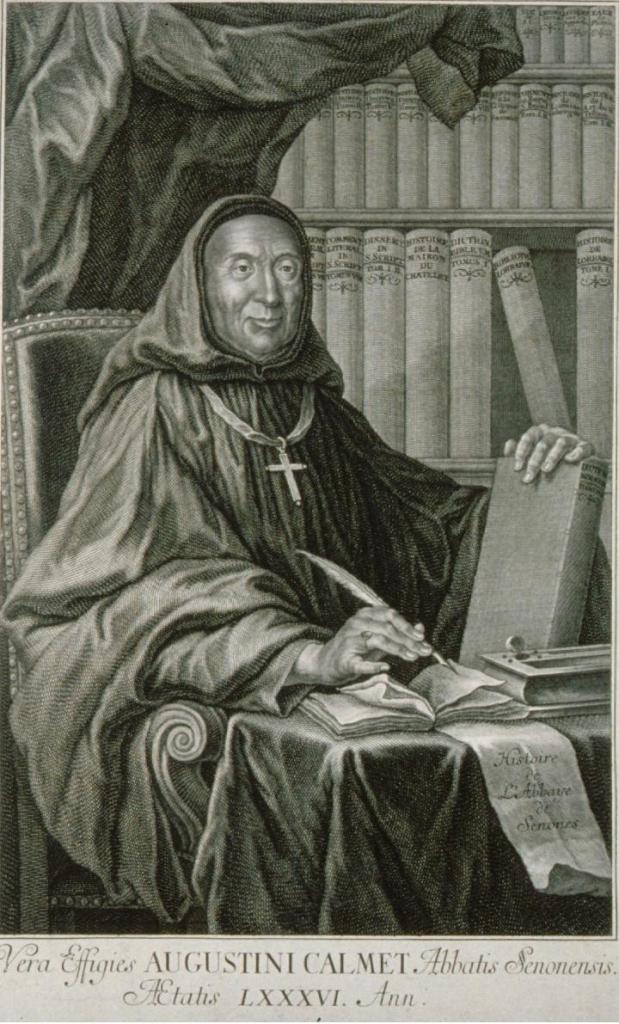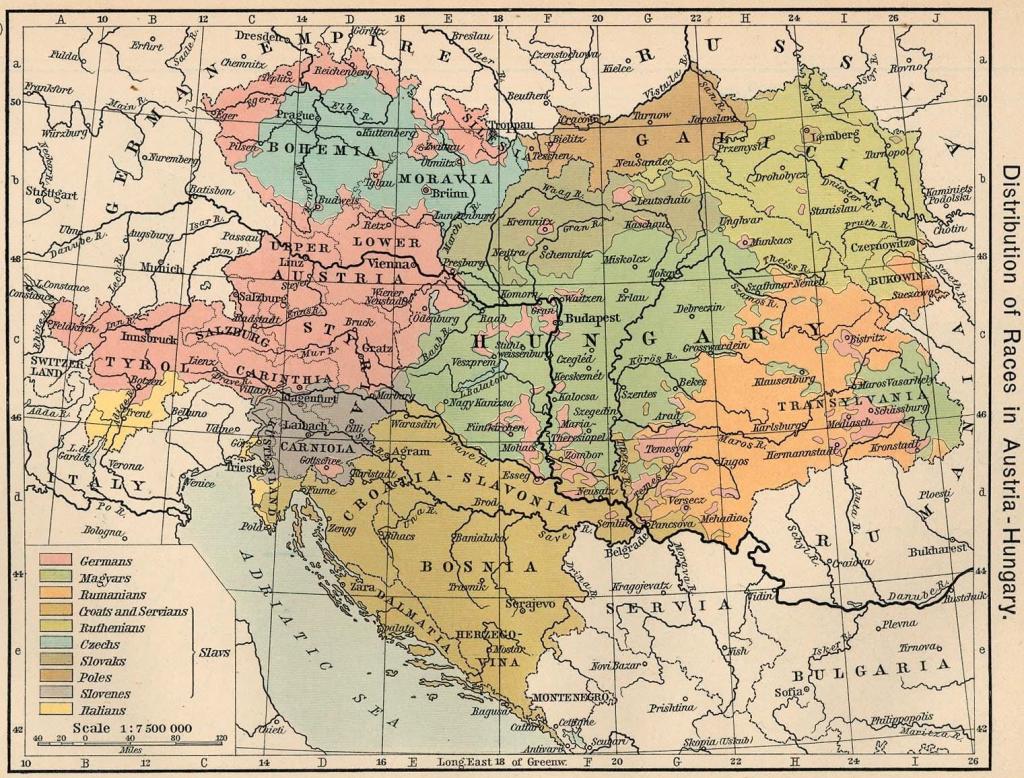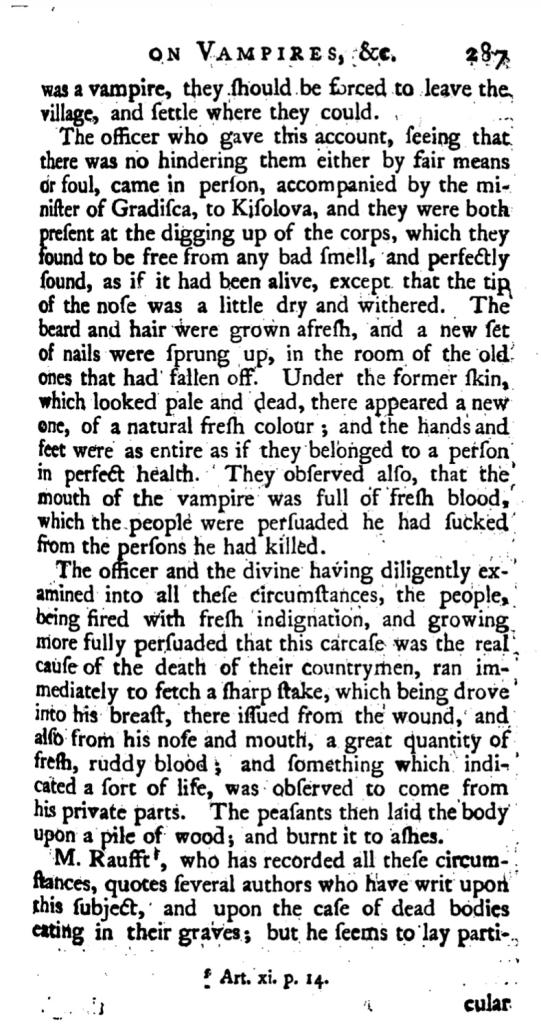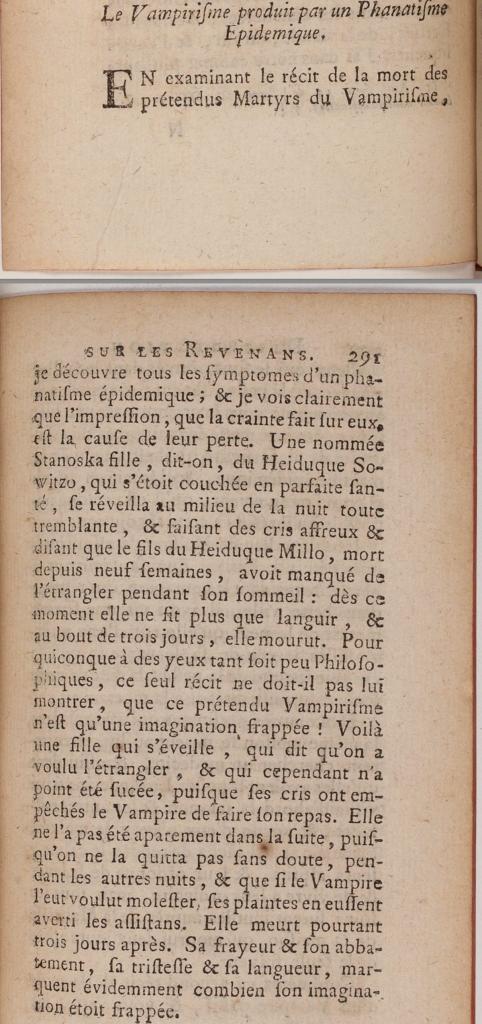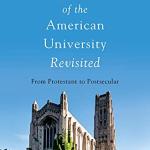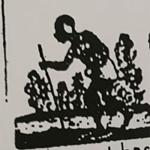If you must, you can read scary recent stories of ghosts and horrors for Halloween, but why not just go right back to the original sources from which all those tales are derived? When you do, you find that those original sources are at least as good as anything imagined by later generations. And as a bonus, you can discover a significant moment in Western religious history, and controversy.
As a case in point, look at the vampires who will be proliferating in this late October season. Yes, we see their immediate sources easily enough, in the novel of Dracula (1897), and countless films. But where do all those ideas come from? Very soon, that question takes us back to an amazing work of Enlightenment scholarship that appeared in 1746, from the pen of a French Benedictine named Antoine Augustin Calmet (1672-1757), who published a vastly influential treatise entitled Dissertations sur les apparitions des anges, des démons et des esprits, et sur les revenants et vampires de Hongrie, de Bohême, de Moravie et de Silésie (an expanded edition appeared in 1751). This translates to Dissertations on the Apparitions of Angels, of Demons and of Spirits, and on Revenants or Vampires of Hungary, of Bohemia, of Moravia and of Silesia, and I will refer to it here as the Dissertations. You may think that you have never heard of Calmet or his book, but if you have ever come across a snippet of vampire lore in popular culture, then you should give thanks to this erudite monk. Bram Stoker certainly drew heavily on his writings to create Dracula. Calmet’s work also explains why, when we think of vampires, we locate them in a mist-shrouded mythic Transylvania of the mind, where the castles and the inns, the burgomeisters and the peasants, look just as they do.
Much as he would have loathed the title, Calmet was the godfather of modern horror writing.
Calmet’s work created a European sensation, and was widely translated. One English version appeared in 1759 as Dissertations upon the Apparitions of Angels, Daemons and Ghosts, and Concerning the Vampires. The standard English edition is the translation by Henry Christmas, published in 1850 as The Phantom World: The History And Philosophy Of Spirits, Apparitions, etc, etc, in which the vampire material is an “etc” in the second volume. Following the link will take you to the full text versions of both translations. Calmet’s work established the idea of the vampire in English culture, from which it later evolved through writings such as John Polidori’s The Vampyre (1819), and Sheridan Le Fanu’s Carmilla (1872). A separate strand in French literature, equally dependent on Calmet, owes its origins to Prosper Mérimée, in his La Guzla (1827), and thence into Russian.
Calmet was a highly esteemed scholar, who wrote very learned Bible commentaries, which erred a little on the side of over-conservatism. But his work on ghosts and vampires took him into very different territory. Remember the date: this was the height of the Enlightenment in France, when virtually all spiritual and supernatural doctrines were facing intense challenge from skeptics and deists. Calmet’s book announced that in the Habsburg realms, a great many people believed very firmly in undead monsters, which were so commonplace and so terrifying as to demand something like an imperial military and judicial campaign.
Nor was Calmet a lone credulous paranoid. His extensive correspondence shows how many other educated people believed these stories. Moreover, they were often good Enlightenment figures in their own right, who struggled to find material and medical explanations for the wonders they witnessed. Had the apparent vampires been buried alive? Were they suffering from some kind of rabies? Might vampirism be, literally, a kind of plague?
Interestingly, Calmet himself often comes across as a skeptic, even when he is discussing these supernatural horrors. He presents the great vampire scare almost as a fad, a moral panic, the sort of thing that people fret about every few years. Those phenomena rise and pass, and are forgotten and mocked. Surprisingly, perhaps, for a faithful Catholic, he includes in this category many aspects of familiar devotion:
The pilgrimages to Rome were formerly very frequent and very famous. All that is fallen away. We have seen provinces over-run with flagellants, and now none of them remain except in the brotherhoods of penitents which are still found in several parts. We have seen in these countries jumpers and dancers, who every moment jumped and danced in the streets, squares or market-places, and even in the churches. The convulsionaries of our own days seem to have revived them; posterity will be surprised at them, as we laugh at them now. Towards the end of the sixteenth and at the beginning of the seventeenth century, nothing was talked of in Lorraine but wizards and witches. For a long time we have heard nothing of them.
To borrow a famous title, these were all examples of Extraordinary Popular Delusions and the Madness of Crowds. And then he offers a nice jibe against the Enlightenment, suggesting that the great thinkers of that movement were themselves modern day fads, and they too would be forgotten:
When the philosophy of M. Descartes appeared, what a vogue it had! The ancient philosophy was despised; nothing was talked of but experiments in physics, new systems, new discoveries. M. Newton appears; all minds turn to him.
And this is the context in which we are to place the fad or vogue of his own day, which has torn apart society across a large part of Central and Eastern Europe:
In this age, a new scene presents itself to our eyes, and has done for about sixty years in Hungary, Moravia, Silesia, and Poland: they see, it is said, men who have been dead for several months, come back to earth, talk, walk, infest villages, ill use both men and beasts, suck the blood of their near relations, make them ill, and finally cause their death; so that people can only save themselves from their dangerous visits and their hauntings by exhuming them, impaling them, cutting off their heads, tearing out the heart, or burning them. These revenans are called by the name of oupires or vampires, that is to say, leeches; and such particulars are related of them, so singular, so detailed, and invested with such probable circumstances and such judicial information, that one can hardly refuse to credit the belief which is held in those countries, that these revenans come out of their tombs and produce those effects which are proclaimed of them. …
The revenans of Hungary, or vampires, which form the principal object of this dissertation, are men who have been dead a considerable time, sometimes more, sometimes less; who leave their tombs, and come and disturb the living, sucking their blood, appearing to them, making a racket at their doors, and in their houses, and lastly, often causing their death. They are named vampires, or oupires, which signifies, they say, in Sclavonic, a leech. The only way to be delivered from their haunting, is to disinter them, cut off their head, impale them, burn them, or pierce their heart.
“Hungary” here refers to the great kingdom of that name, which stretched considerably further than the modern nation, and included bits of what we would call Romania, Slovakia, and Croatia – including Transylvania itself. That geographical context gets to a whole other agenda here that I don’t want to get into too much, but I should mention it. In 1612, the Hungarian Countess Elizabeth Báthory was accused of a series of monstrous crimes against young women, which were magnified in later mythology to include her bathing in the blood of virgins, although there is plenty of debate about which if any of those tales were true. The records of the trial were sealed, but they came to light in the eighteenth century, and were sensationally publicized in the 1729 book Tragica Historia by Jesuit historian László Turóczi, who included the most grotesque charges and allegations, and many other books followed. Although vampirism was not one of those charges, the image of the (literally) bloodthirsty aristocrat in the castle on the hill has led to her being called “Countess Dracula” in many modern accounts, not to mention one great Hammer film. The Countess was based in the castle of Csejte, in what we would call the far west of Slovakia.
For present purposes, the point is that in the 1730s, in Calmet’s time, those regions of Central Europe already had a reputation for frightful horror stories with what we might, slightly anachronistically, call a Gothic flavor: Turóczi himself was a near contemporary of Calmet. This was the sort of place where such gory things were meant to happen. Moreover, civilized West Europeans asserted their own sophistication and Enlightenment by stressing how radically different they were from those still-medieval folks to the east: think of this as a kind of short-range Orientalism.
Getting back to Calmet, he then goes on to offer many examples of such vampire stories, none of which would cause the slightest surprise to anyone who ever saw a modern horror film. Most come from official or judicial records, with a heavy concentration on the years since the late 1720s. I will quote one example at some length, from 1738, but I repeat, this is one of a great many:
We have just had in this part of Hungary a scene of vampirism, which is duly attested by two officers of the tribunal of Belgrade, who went down to the places specified; and by an officer of the emperor’s troops at Graditz, who was an ocular witness of the proceedings.
In the beginning of September there died in the village of Kivsiloa, three leagues from Graditz, an old man who was sixty-two years of age. Three days after he had been buried, he appeared in the night to his son, and asked him for something to eat; the son having given him something, he ate and disappeared. The next day the son recounted to his neighbors what had happened. That night the father did not appear; but the following night he showed himself, and asked for something to eat. They know not whether the son gave him anything or not; but the next day he was found dead in his bed. On the same day, five or six persons fell suddenly ill in the village, and died one after the other in a few days.
The officer or bailiff of the place, when informed of what had happened, sent an account of it to the tribunal of Belgrade, which dispatched to the village two of these officers and an executioner to examine into this affair. The imperial officer from whom we have this account repaired thither from Graditz, to be witness of a circumstance which he had so often heard spoken of.
They opened the graves of those who had been dead six weeks. When they came to that of the old man, they found him with his eyes open, having a fine color, with natural respiration, nevertheless motionless as the dead; whence they concluded that he was most evidently a vampire. The executioner drove a stake into his heart; they then raised a pile and reduced the corpse to ashes. No mark of vampirism was found either on the corpse of the son or on the others.
Thanks be to God, we are by no means credulous. We avow that all the light which physics can throw on this fact discovers none of the causes of it. Nevertheless, we cannot refuse to believe that to be true which is juridically attested, and by persons of probity.
Calmet draws widely on local correspondents, who report for instance that
A little before, he says that in 1732 they discovered again some vampires in Hungary, Moravia, and Turkish Servia; that this phenomenon is too well averred for it to be doubted; that several German physicians have composed pretty thick volumes in Latin and German on this matter; that the Germanic Academies and Universities still resound with the names of Arnald Paul, of Stanoska, daughter of Sovitzo, and of the Heyducq Millo, all famous vampires of the quarter of Médreiga, in Hungary.
The Dissertations offers details of several such notorious cases:
About five years ago, a certain Heyducq, inhabitant of Madreiga, named Arnald Paul, was crushed to death by the fall of a wagonload of hay. Thirty days after his death four persons died suddenly, and in the same manner in which according to the tradition of the country, those die who are molested by vampires. They then remembered that this Arnald Paul had often related that in the environs of Cassovia, and on the frontiers of Turkish Servia, he had often been tormented by a Turkish vampire; for they believe also that those who have been passive vampires during life become active ones after their death, that is to say, that those who have been sucked suck also in their turn; but that he had found means to cure himself by eating earth from the grave of the vampire, and smearing himself with his blood; a precaution which, however, did not prevent him from becoming so after his death, since, on being exhumed forty days after his interment, they found on his corpse all the indications of an arch-vampire. His body was red, his hair, nails, and beard had all grown again, and his veins were replete with fluid blood, which flowed from all parts of his body upon the winding-sheet which encompassed him.
The hadnagi, or bailli of the village, in whose presence the exhumation took place, and who was skilled in vampirism, had, according to custom, a very sharp stake driven into the heart of the defunct Arnald Paul, and which pierced his body through and through, which made him, as they say, utter a frightful shriek, as if he had been alive: that done, they cut off his head, and burnt the whole body. After that they performed the same on the corpses of the four other persons who died of vampirism, fearing that they in their turn might cause the death of others.
All these performances, however, could not prevent the recommencement of these fatal prodigies towards the end of last year, that is to say, five years after, when several inhabitants of the same village perished miserably. In the space of three months, seventeen persons of different sexes and different ages died of vampirism; some without being ill, and others after languishing two or three days. It is reported, amongst other things, that a girl named Stanoska, daughter of the Heyducq Jotiützo, who went to bed in perfect health, awoke in the middle of the night all in a tremble, uttering terrible shrieks, and saying that the son of the Heyducq Millo who had been dead nine weeks, had nearly strangled her in her sleep. She fell into a languid state from that moment, and at the end of three days she died. What this girl had said of Millo’s son made him known at once for a vampire: he was exhumed, and found to be such. The principal people of the place, with the doctors and surgeons, examined how vampirism could have sprung up again after the precautions they had taken some years before.
They discovered at last, after much search, that the defunct Arnald Paul had killed not only the four persons of whom we have spoken, but also several oxen, of which the new vampires had eaten, and amongst others the son of Millo. Upon these indications they resolved to disinter all those who had died within a certain time, &c. Amongst forty, seventeen were found with all the most evident signs of vampirism; so they transfixed their hearts and cut off their heads also, and then cast their ashes into the river.
You don’t have to believe any of these reports as literal to accept that a real scare or panic was in progress. As more stories mounted, so people noting a wave of sudden deaths would leap to supernatural conclusions, and go exhuming the bodies of likely vampires. Meanwhile, people terrified of the danger were liable to emotional or mental collapse, and even death. Calmet spoke aptly of a “phanatisme epidemique” – mass hysteria is a close equivalent:
On examining the narrative of the death of the pretended martyrs of vampirism, I discover the symptoms of an epidemical fanaticism; and I see clearly that the impression made upon them by fear is the true cause of their being lost.
That is a sane, and quite realistic analysis.
Calmet’s dating of all this to the previous sixty years is interesting. That would take us back to the great Habsburg reconquest of the region in the 1680s, and the reoccupation of large sections of previously Ottoman territory. Religious relations were very sensitive, with Catholic and Orthodox living near each other, often with close memories of recent Muslim dominance. This might well have provided an unsettling context to tales surrounding sacred places, and overlapping folk-tales. Literally, these regions were liminal, borderlands, in multiple senses. But whatever the origins, the great vampire scare prevailed for some decades.
The good news for us today is that if we look at the wonderful resources offered by the Internet, there is some terrific seasonal reading waiting for us.
Some recent scholarship on the whole affair includes
Ciaran Craig, “Augustin Calmet and the Construction of the Eighteenth-Century Vampire,” Central European Yearbook 3(2021)
Matthew Gibson, Dracula and the Eastern Question: British and French Vampire Narratives of the Nineteenth-Century Near East (Palgrave Macmillan, 2006)
Nick Groom, The Vampire: A New History (Yale, 2018)
Gianfranco Manfredi, “Voltaire et les vampires,” Multitudes 33(2008), 91-99
Fernando Vidal, “Ghosts Of The European Enlightenment,” in Mu-chou Poo, ed., Rethinking Ghosts in World Religions (Brill, 2009): 163–182
Also a great many books on vampires by my former Baylor colleague Gordon Melton, who might actually be a reincarnation of Augustin Calmet. Are Benedictines allowed to reincarnate?


